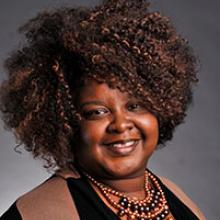A Quick Word About Educational Leadership With: Tammie M. Causey-Konaté
Tammie M. Causey-Konaté, deputy director of the Southeast Comprehensive Center and senior technical assistance consultant at AIR, lived through the stress and displacement of Hurricane Katrina in 2005. In the aftermath, she connected with fellow educators and writers who documented their experiences and developed a tiered approach to disaster recovery for education systems and students who experience trauma. Causey-Konaté co-edited their 2018 book, Called to Sankofa: Leading In, Through and Beyond Disaster—A Narrative Account of African Americans Leading Education in Post-Katrina New Orleans.
Q: How did the book come about?
Causey-Konaté: After the hurricane, many of my colleagues at Dillard University and over 4,000 educators in the city—many of whom had excellent educational experiences and performance records—lost their jobs. The media portrayed our community and citizens in a very negative light. We were referred to as criminals and refugees, with very dark imagery and third-world connotations. New Orleans was characterized as a city of deficits, of underperformance and extreme corruption politically and financially, and that pervaded K–12 and higher education.
There was some truth to that, but it wasn’t the whole truth. Many of us were still working actively within our own circumstances to survive, but we were still teaching and leading the recovery efforts. We were the first educational responders. That was not in the literature. I was concerned about that, and I wanted to challenge those master narratives and half-truths that were being documented as reality in our history.
Q: How did you capture the story of educational leadership in times of trauma and recovery?
Causey-Konaté: We wanted to retrieve and leverage our strengths across the K–12 and higher education landscapes. Our group included leaders across the spectrum—college and university leaders, the board president for Orleans Parish Schools, the leader of one of the first recovery school districts, community and spiritual leaders, and advocates for children.
We developed a framework for supporting them, which is really a lens for healing and examining leadership. We called the work Sankofa, a West African term that means “return to the source and fetch.” Through this framework, we helped them to think about what valuables were left behind and could be recovered.
We wanted to tell their stories in a way to show the evolution of their leadership—how their resilience overshadowed their trauma, how they were able to work through the trauma and engage the community. Each chapter of the book has a personal and professional story and kernels of wisdom from a traumatic situation, with the intention of empowering and arousing agency among ourselves and in the larger community.
We also wanted to think about sustainable solutions that would be immediate and serve a purpose. We developed a tiered approach to recovery that offers lessons learned in terms of policies, procedures, practical resources, facilities, and outcomes. We shared how we navigated those with leadership, partnerships, and communications plans, and by securing vital records and engaging parents. Our plan was to work with K–12 schools, universities, and other agencies to help them take a proactive approach to preserving vital documents, processes, and procedures, so that in the face of disaster, people would not lose as much and recovery time would be diminished. By developing strong relationships and partnerships, we were able to help increase everyone’s capacity.
Q: How do the themes of this book connect to your work at AIR?
Causey-Konaté: The work I do through the Southeast Comprehensive Center’s Mississippi Talent Management project is pertinent to the book. The Talent for Turnaround Leadership Academy (T4TLA) is the centerpiece of this project. An important part of our work is helping district and school leaders remember to look back while moving forward, so their work is informed by bits of history and passion along with new knowledge to empower their schools and students.
Mississippi also is participating with other states to examine their talent data and learn more about the extent to which they’re able to recruit, develop, and maintain high-quality teachers and develop diverse and learner-ready teachers. In collaboration with the Center on Great Teachers and Leaders and the Council of Chief State School Officers’ Diverse and Learner-Ready Teacher initiative, we are helping states like Connecticut and Mississippi diversify the workforce with culturally competent hiring practices.
The Southeast Comprehensive Center serves over 2 million children indirectly. In 2018, we convened an Equity Summit to help states to set strategic plans that will result in diversifying their educator workforces and ensure that all teachers are becoming more culturally and linguistically competent.
